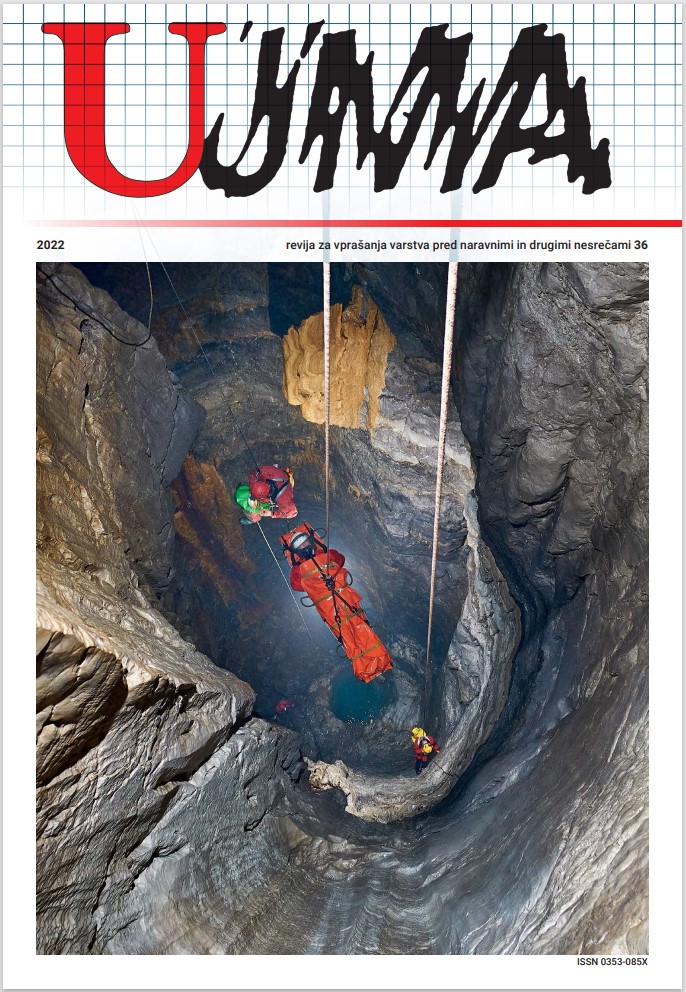COMPARISON OF CHARACTERISTIC DISCHARGES OF SLOVENIAN RIVERS OF THE NEW REFERENCE PERIOD 1991-2020 WITH PREVIOUS REFERENCE PERIODS
Abstract
The choice of the long-term 30-year reference period has a strong influence on the values of characteristic periodic discharges. Following the recommendation of the World Meteorological Organization that the 30-year standard reference periods should be updated every decade, the Slovenian Environmental Agency has begun introducing a new reference period, 1991-2020, to compare current observational data with long-term averages. This paper presents the impact of the 30-year reference periods recommended in historical practice by the World Meteorological Organization on the values of mean, low and high discharges for the six water gauging stations with the longest continuous data sets. The results show that the highest values of the mean periodic discharges are mostly for the period 1931-1960 and the lowest for the period 1981-2010. The new reference period, 1991-2020, gives a slight increase in mean discharges. Mean low periodic discharges are highest for the period 1961-1990 and lowest for the periods 1981-2010 and 1991-2020. Mean high periodic discharges are highest for the periods 1961-1990 and 1991-2020 and lowest for the period 1931-1960. A comparison of the characteristic discharges of the new reference period, 1991- 2020, with the previous period, 1981-2010, shows that there are no significant differences between these periods on an annual scale. However, there are major differences on the monthly scale. In the period 1991-2020, compared to 1981-2010, February discharges increased the most. From April to August, the values of all the characteristic discharges of the period 1991-2020 fell below the values of the period 1981-2010. Mean discharges also increased in September and November. In other months, there were no significant differences.
References
ARSO, 2022. Arhiv hidroloških podatkov površinskih voda Agencije RS za okolje. http://vode.arso.gov.si/hidarhiv/pov_arhiv_tab.php.
ARSO, 2021. Pregled hidroloških razmer površinskih voda v Sloveniji: Poročilo o monitoringu za leto 2019. Ljubljana: Ministrstvo za okolje in prostor, Agencija Republike Slovenije za okolje. http://www.arso.gov.si/vode/poročila%20in%20publikacije/, 6. 4. 2022.
Bertalanič, R., Dolinar, M., Draksler, A., Honzak, L., Kobold, M., Kozjek, K., Lokpošek, N., Medved, A., Vertačnik, G., Vlahović, Ž., Žust, A., 2018. Ocena podnebnih sprememb v Sloveniji do konca 21. stoletja. Sintezno poročilo – prvi del. Ljubljana: Ministrstvo za okolje in prostor, Agencija Republike Slovenije za okolje.
Copernicus, 2021. New decade brings reference period change for climate data. Changing the reference period from 1981-2020 to 1991-2020 for the C3S Climate Bulletin. https://climate.copernicus.eu/new-decade-brings-reference-period-change-climate-data, 21. 4. 2022.
Kobold, M., 2020. Vpliv izbire primerjalnega obdobja na vrednosti obdobnih značilnih pretokov pri daljših časovnih nizih podatkov. V: Zbornik 31. Mišičev vodarski dan, Maribor, Vodnogospodarski biro, 105–108. http://www.mvd20.com/LETO2020/R15.pdf, 7. 4. 2022.
Kobold, M., Dolinar, M., 2014. Podnebne spremembe v Sloveniji in njihov vpliv na vodni režim. V: Cerkvenik, S., Rojnik, E. (urednika), Zbornik referatov: simpozij z mednarodno udeležbo, Ljubljana, Slovensko društvo za zaščito voda, 117–131.
Kobold, M., Gačnik, N., Plečko, J., Vujinović, A., Klančar, K., 2019. Scenariji spremembe pretokov rek v Sloveniji do konca 21. stoletja. V: Zbornik: Raziskave s področja geodezije in geofizike 2018, Ljubljana, Fakulteta za gradbeništvo in geodezijo, 89–100.
NOAA, 2021. NOAA Delivers New U.S. Climate Normals. Decadal update from NCEI gives forecasters and public latest averages for 1991–2020. https://www.ncei.noaa.gov/news/noaa-delivers-new-usclimate-normals, 21. 4. 2022.
Oblak, J., Kobold, M., Šraj, M., 2021. The influence of climate change on discharge fluctuations in Slovenian rivers, Acta geographica Slovenica, 61-2, 155–169.
Sušnik, A., Gregorič, G., Uhan, J., Kobold, M., Andjelov, M., Petan, S., Pavlič, U., Valher, A., 2013. Spremenljivost suš v slovenskem prostoru in analiza suše 2013. V: Zbornik 24. Mišičev vodarski dan 2013, Maribor, Vodnogospodarski biro, 102–109.
Tveito, O. E., 2021. Norwegian standard climate normals 1991-2020 - the methodological approach, METreport, Norvegian Meteorological Institute.
Ulaga, F., Kobold, M., Frantar, P., 2008. Trends of river discharges in Slovenia. V: Brilly, Mitja (ur.). XXIVth Conference of the Danubian Countries on the Hydrological Forecasting and Hydrological Bases of Water Management, London.
Uredba o kriterijih za določitev ter načinu spremljanja in poročanja ekološko sprejemljivega pretoka, 2009. Uradni list RS, št. 97/09.
WMO, 2020. Updated 30-year reference period reflects changing climate. https://public.wmo.int/en/media/news/updated-30-yearreference-period-reflects-changing-climate, 5. 5. 2021.
WMO, 2017. WMO Guidelines on the Calculation of Climate Normals, WMO-No. 1203, Geneva.
WMO, 2015. Technical Regulations, Volume I: General Meteorological Standards and Recommended Practices, WMO-No. 49, Geneva.
WMO, 2011. Guide to Climatological Practices, WMO-No. 100, Geneva.
WMO, 2007. The Role of Climatological Normals in a Changing Climate, WMO/TD No. 1377, Geneva.
Downloads
Published
Issue
Section
License

This work is licensed under a Creative Commons Attribution-NonCommercial-NoDerivatives 4.0 International License.
The articles are made available to the public under Creative Commons Attribution-NonCommercial-NoDerivatives 4.0 International (CC BY-NC-ND 4.0).


